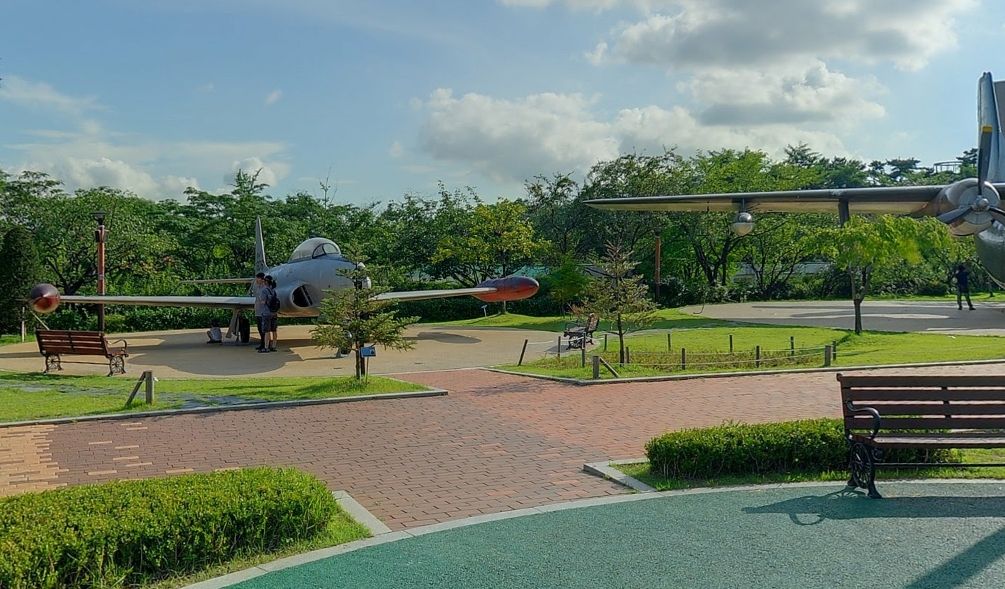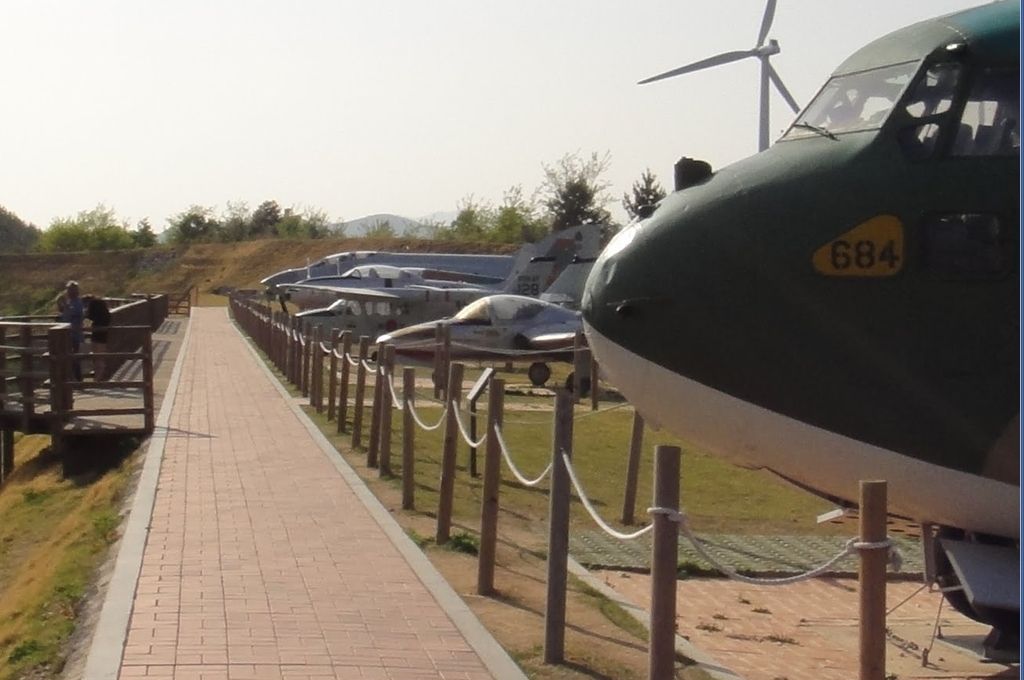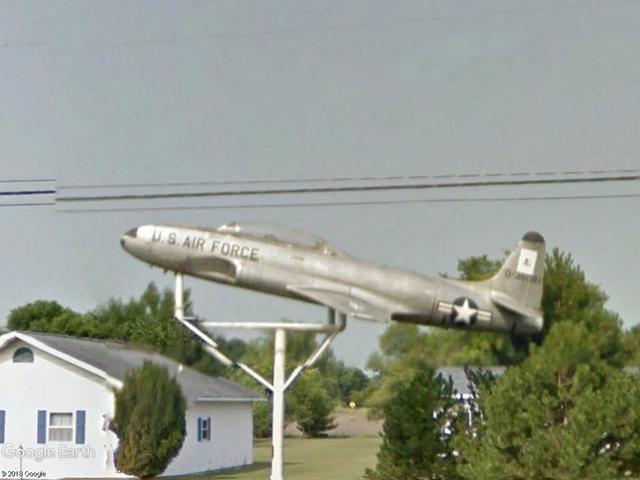Post by carmedic on Apr 6, 2015 20:11:36 GMT
First posted on oGEC 04/12/07
Lockheed T-33 Shooting Star's visible in GE



The Lockheed T-33 Shooting Star is an American-built jet trainer. It was produced by Lockheed and made its first flight in 1948, piloted by Tony LeVier. The T-33 was developed from the Lockheed P-80/F-80 starting as TP-80C/TF-80C in development, then designated T-33A. It was used by the USN as the initially as TO-2 then TV-2 and after 1962, T-33B. Despite its vintage, the venerable T-33 still remains in service worldwide.
The T-33 was developed from the Lockheed P-80/F-80 by lengthening the fuselage by slightly over three feet and adding a second seat, instrumentation and flight controls. It was initially designated as a variant of the P-80/F-80, the TP-80C/TF-80C.
Design work for the Lockheed P-80 began in 1943 with the first flight on 8 January 1944. Following on the Bell P-59, the P-80 became the first jet fighter to enter full squadron service in the US Army Air Force. As more advanced jets entered service, the F-80 took on another role - training jet pilots. The two-place T-33 jet was designed for training pilots already qualified to fly propeller-driven aircraft.
Originally designated the TF-80C, the T-33 made its first flight on 22 March 1948 with US production taking place from 1948 to 1959. The US Navy used the T-33 as a land-based trainer starting in 1949. It was designated the TV-2, but was redesignated the T-33B in 1962. The Navy operated some ex-USAF P-80Cs as the TO-1, changed to the TV-1 about a year later. A carrier capable version of the P-80/T-33 family was subsequently developed by Lockheed, eventually leading to the late 1950s to 1970s T2V-1/T-1A SeaStar. A total of 6,557 Shooting Stars were produced, 5,691 by Lockheed.
The T-33 has served with over 30 nations, and continues to operate as a trainer in smaller air forces. Canadair built 656 T-33s on licence for service in the Canadian Forces as the CT-133 Silver Star while Kawasaki manufactured 210 in Japan. Other operators included Brazil, Turkey and Thailand which used the T-33 extensively.
Specifications (T-33A)
General characteristics
Crew: Two
Length: 37 ft 9 in (11.2 m)
Wingspan: 38 ft 10.5 in (11.5 m)
Height: 11 ft 8 in (3.3 m)
Empty weight: 8,300 lb (3,775 kg)
Max takeoff weight: 15,100 lb (6,865 kg)
Powerplant: 1� Allison J33-A-35 centrifugal compressor turbojet, 5,400 lbf (23 kN)
Performance
Maximum speed: 600 mph (970 km/h)
Range: 1,275 miles ferry (2,050 km)
Service ceiling: 48,000 ft (14,600 m)
Armament
(AT-33) 2x 0.50 in (12.7 mm) Browning M3 machine guns with 350 rounds per gun
Up to 2,000 lb (907 kg) of ordnance on two underwing hardpoints. Weapons carried include bombs and rocket pods
Operators
Belgium Bolivia Brazil Burma Canada Chile Republic of China Colombia Cuba Denmark Ecuador El Salvador France Germany Greece Guatemala Indonesia Iran Italy Japan Libya Mexico Netherlands Nicaragua Norway Pakistan Paraguay Peru Philippines Portugal Saudi Arabia Singapore
South Korea Spain Thailand Turkey United States: US Air Force, US Navy
Uruguay Venezuela Yugoslavia
This collection is not yet complete, please feel free to post any I have missed, but try to add a photo and ID of any you find.
Most placemarks contain a photo and ID of the aircraft in the GE shot.
Lockheed T-33 Collection03-09-09.kmz (106.45 KB)
Lockheed T-33 Shooting Star's visible in GE



The Lockheed T-33 Shooting Star is an American-built jet trainer. It was produced by Lockheed and made its first flight in 1948, piloted by Tony LeVier. The T-33 was developed from the Lockheed P-80/F-80 starting as TP-80C/TF-80C in development, then designated T-33A. It was used by the USN as the initially as TO-2 then TV-2 and after 1962, T-33B. Despite its vintage, the venerable T-33 still remains in service worldwide.
The T-33 was developed from the Lockheed P-80/F-80 by lengthening the fuselage by slightly over three feet and adding a second seat, instrumentation and flight controls. It was initially designated as a variant of the P-80/F-80, the TP-80C/TF-80C.
Design work for the Lockheed P-80 began in 1943 with the first flight on 8 January 1944. Following on the Bell P-59, the P-80 became the first jet fighter to enter full squadron service in the US Army Air Force. As more advanced jets entered service, the F-80 took on another role - training jet pilots. The two-place T-33 jet was designed for training pilots already qualified to fly propeller-driven aircraft.
Originally designated the TF-80C, the T-33 made its first flight on 22 March 1948 with US production taking place from 1948 to 1959. The US Navy used the T-33 as a land-based trainer starting in 1949. It was designated the TV-2, but was redesignated the T-33B in 1962. The Navy operated some ex-USAF P-80Cs as the TO-1, changed to the TV-1 about a year later. A carrier capable version of the P-80/T-33 family was subsequently developed by Lockheed, eventually leading to the late 1950s to 1970s T2V-1/T-1A SeaStar. A total of 6,557 Shooting Stars were produced, 5,691 by Lockheed.
The T-33 has served with over 30 nations, and continues to operate as a trainer in smaller air forces. Canadair built 656 T-33s on licence for service in the Canadian Forces as the CT-133 Silver Star while Kawasaki manufactured 210 in Japan. Other operators included Brazil, Turkey and Thailand which used the T-33 extensively.
Specifications (T-33A)
General characteristics
Crew: Two
Length: 37 ft 9 in (11.2 m)
Wingspan: 38 ft 10.5 in (11.5 m)
Height: 11 ft 8 in (3.3 m)
Empty weight: 8,300 lb (3,775 kg)
Max takeoff weight: 15,100 lb (6,865 kg)
Powerplant: 1� Allison J33-A-35 centrifugal compressor turbojet, 5,400 lbf (23 kN)
Performance
Maximum speed: 600 mph (970 km/h)
Range: 1,275 miles ferry (2,050 km)
Service ceiling: 48,000 ft (14,600 m)
Armament
(AT-33) 2x 0.50 in (12.7 mm) Browning M3 machine guns with 350 rounds per gun
Up to 2,000 lb (907 kg) of ordnance on two underwing hardpoints. Weapons carried include bombs and rocket pods
Operators
Belgium Bolivia Brazil Burma Canada Chile Republic of China Colombia Cuba Denmark Ecuador El Salvador France Germany Greece Guatemala Indonesia Iran Italy Japan Libya Mexico Netherlands Nicaragua Norway Pakistan Paraguay Peru Philippines Portugal Saudi Arabia Singapore
South Korea Spain Thailand Turkey United States: US Air Force, US Navy
Uruguay Venezuela Yugoslavia
This collection is not yet complete, please feel free to post any I have missed, but try to add a photo and ID of any you find.
Most placemarks contain a photo and ID of the aircraft in the GE shot.
Lockheed T-33 Collection03-09-09.kmz (106.45 KB)







